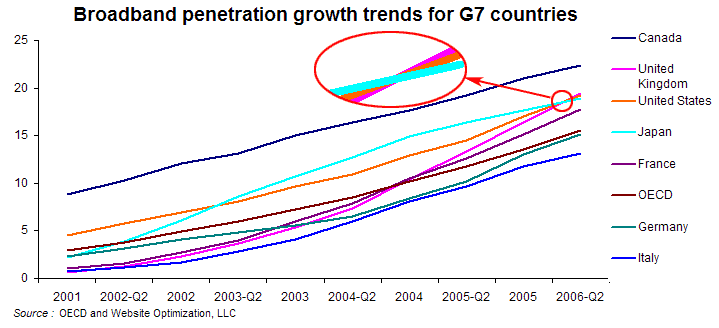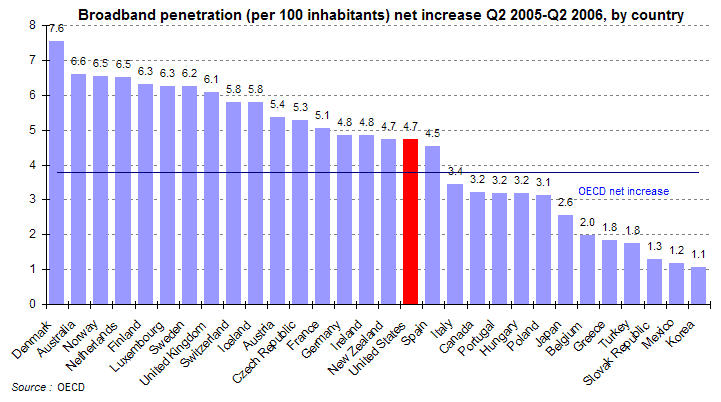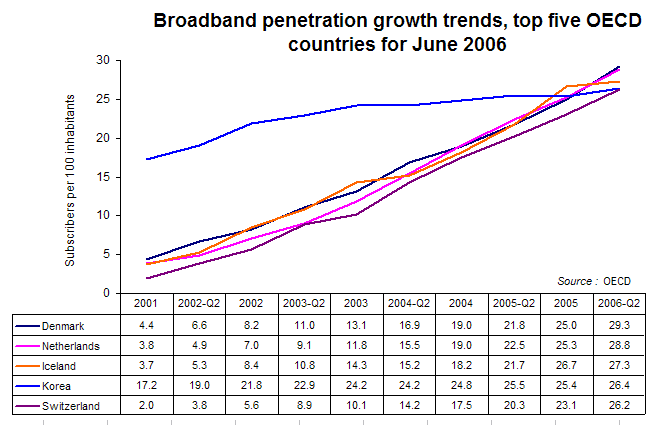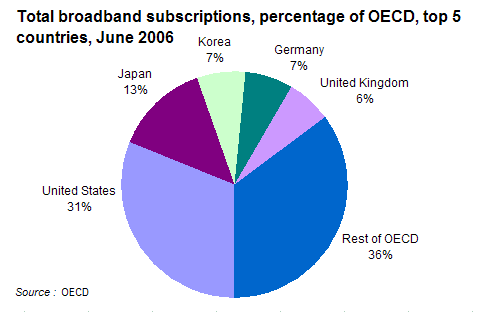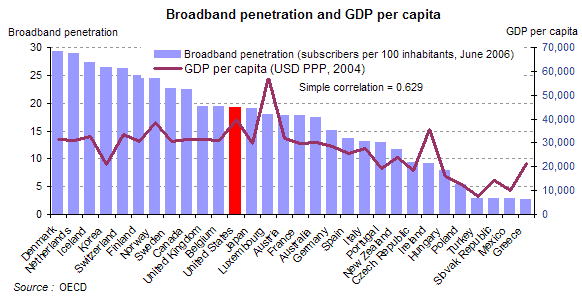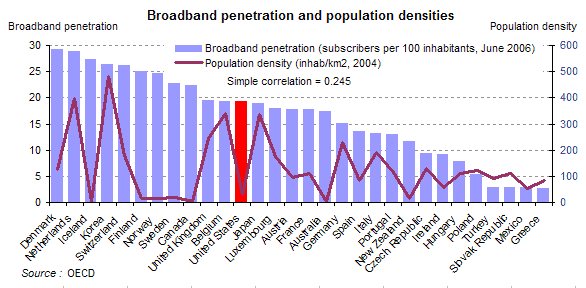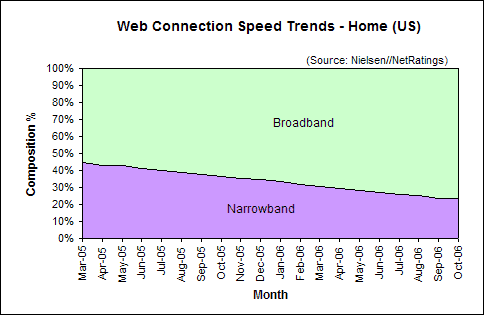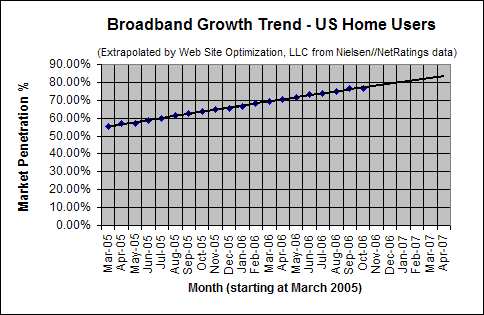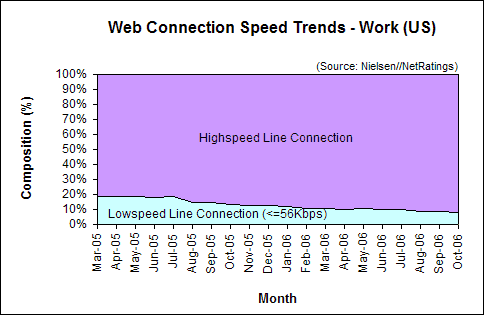The UK passed Japan and the US in broadband penetration in the first quarter of 2006 (see Figure 1). Among G7 countries, only Canada had a higher broadband penetration rate, according to a recent broadband survey by OECD. The UK’s faster growth rate, over twice that of Japan, propelled it past Japan around March of 2006 (see Figure 2). Meanwhile in the US, broadband growth slowed in October, growing only 0.27% percentage points to 76.6% among active Internet users over the past month.
Figure 1: Broadband Penetration Growth Trends for G7 Countries 2001 – Q22006
Source: OECD and Website Optimization
UK Passes Japan in Broadband Penetration
Over the past year, the UK added a net increase of 6.1 subscribers per 100 inhabitants. The US added 4.7 subscribers, while Japan added 2.6 (see Figure 2). As predicted the UK’s superior growth rate propelled it past the US and Japan to become second only to Canada among G7 countries surveyed in broadband penetration.
Figure 2: Broadband Penetration Net Growth for OECD Countries Q205 – Q206
Source: OECD and Website Optimization
Switzerland Passes Korea in Broadband Penetration
Among the top 5 countries in broadband penetration per 100 inhabitants, Denmark, the Netherlands, and Switzerland all show faster growth rates, while Iceland and Korea are leveling off (see Figure 3). At these growth rates Switzerland passed Korea to become fourth overall in broadband penetration worldwide in the third quarter of 2006.
Figure 3: Broadband Penetration Growth for Top 5 OECD Countries 2001 – Q2 2006
Source: OECD and Website Optimization
Total Broadband Subscribers
Over the past year, the US has maintained its lead with 31% of total broadband subscribers worldwide. While they have added subscribers over the past year, Japan, Korea, and Germany have lost ground percentage-wise as broadband spreads to other countries, dropping from 15% to 13%, 9% to 7%, and 7% to 6% respectively (see Figure 4 and UK Passes US in Broadband Penetration). The UK maintained its fourth place position over the past year with 6% of total broadband subscribers.
Figure 4: Total Broadband Subscriptions as a Percentage of OECD for Top 5 Countries June 2006
Source: OECD and Website Optimization
Broadband Penetration Correlates with GDP Per Capita, not Population Density
Broadband penetration appears to have a stronger correlation with GDP per capita (see Figure 5) than with population density. Broadband penetration had a correlation of 0.629 with GDP per capita and a correlation of 0.245 with population density (see Figure 6).
Figure 5: Broadband Penetration by Country and GDP Per Capita – June 2006
Source: OECD and Website Optimization
Figure 6: Broadband Penetration by Country and Population Density – June 2006
Source: OECD and Website Optimization
Home Connectivity in the US
US broadband penetration among active Internet users grew to 76.6% in October 2006. Narrowband users connecting at 56Kbps or less now comprise 23.4% of active Internet users, down 0.27 percentage points from 23.67% in September 2006 (see Figure 7).
Web Connection Speed Trends – Home Users (US)
Figure 7: Web Connection Speed Trends – Home Users (US)
Source: Nielsen//NetRatings
Broadband Growth Trends in the US
In October 2006, broadband penetration in US homes grew 0.27 percentage points to 76.6%, up from 76.33% in September. This increase of 0.27 points is well below the average increase in broadband of 1.16 points per month over the last six months (see Figure 8). At current growth rates US broadband penetration should break 80% among active Internet users by January 2007 (note the slowdown, last month’s prediction was December 2006).
Broadband Adoption Growth Trend – Home Users (US)
Figure 8. Broadband Adoption Growth Trend – Home Users (US)
Extrapolated from Nielsen//NetRatings data
Work Connectivity
As of October 2006, 91.71% of US workers were on broadband, up 0.29 percentage points from the 91.42% share in September. At work 8.29% connect at 56Kbps or less (see Figure 9).
Web Connection Speed Trends – Work Users (US)
Figure 9: Web Connection Speed Trends – Work Users (US)
Source: Nielsen//NetRatings
Further Reading
- Nielsen//NetRatings
- Provided the US broadband penetration data for active Internet users for the Bandwidth Report.
- Organisation for Economic Co-operation and Development (OECD)
- “OECD Broadband Statistics to June 2006” report provided the worldwide broadband data for the Bandwidth Report.
- UK Passes US in Broadband Penetration
- The UK passed the US for the first time in broadband penetration on a per-capita basis in August 2005. The US continued its fall to 13th in broadband penetration among all OECD countries, yet leads all countries surveyed in total broadband subscriptions. Finland, the Netherlands, and Norway lead the pack in broadband penetration growth. From the October 2005 Bandwidth Report.

